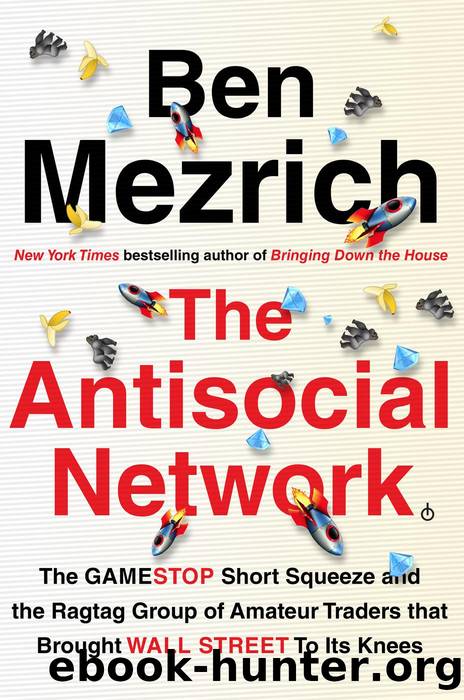The Antisocial Network: The GameStop Short Squeeze and the Ragtag Group of Amateur Traders That Brought Wall Street to Its Knees by Ben Mezrich

Author:Ben Mezrich [Mezrich, Ben]
Language: eng
Format: epub
Tags: Business & Economics, Consumer Behavior, Finance, Wealth Management, Corporate & Business History
ISBN: 9781538707555
Google: IHRnzgEACAAJ
Publisher: Grand Central Publishing
Published: 2021-09-07T23:45:44.323916+00:00
Left had further added, in a video posted to YouTube, that âheâd never seen such an exchange of ideas of people so angry about someone joining the other side of a trade.â
Clearly, what was going on with GameStop wasnât normal, and in decades on Wall Street, Jim had never seen anything quite like it before. No doubt, the emotional component of what was happening fed into the chaos he was seeing on the clearing side of the equation; the volumes, the volatilityâall of it represented abnormal trading patterns, because the trading going on was being powered by abnormal trading motives. Markets were supposed to be rationalâbut there was nothing rational about people who loved a stock so much, theyâd harass the family of someone on the other side of the trade.
Still, despite the strangeness of the market and the chaos in the stock, Jim felt certain that on the clearing side, everything was under control. The automated systems had kicked in as they were supposed to; for several weeks already, his systems had raised the margin requirements surrounding GameStop to take some of the risk out of the equation. As things started to get crazy, you could still buy GameStop on margin at Robinhood, but only at 50 percent of the usual rate. Eventually, that number would change to 100 percentâmeaning buying GameStop on margin would no longer be possible. This sort of control might upset some customers, but it wasnât just to protect Robinhoodâs deposit requirementsâwhich were partially based on risk profiles of tradesâbut also to protect the customers themselves.
Jim believed a large part of his duties were to watch out for those customersâRobinhoodâs users. Commission-free trades and zero account requirements were only part of the picture; payment for order flow, as much as it benefitted Robinhood, also led to even more cost savings to the customers, because the trades flowed through market makers who were constantly looking for the best and most efficient settlements. That was why the majority of Robinhoodâs trades flowed through Citadel, the massive Chicago-based financial firm founded by Ken Griffin, who now handled 40 percent of all retail trades, precisely because they were the best at what they did. Through Citadel, Robinhoodâs PFOF strategy had saved its customers $1 billion in the past year alone, by finding the best bids and offers and completing them the most efficient way.
Of course, the ins and outs of PFOF were as complicated as the minutiae involved in clearing. The bottom line was, Jim and Robinhood were determined to keep their retail traders happy and safe. Sometimes, this meant leaning hard in one direction or the other. As long as the volatility in GameStop continued, efforts like limiting margin trades would have to be made. Though some users might find it constraining, sometimes a bit of constraint was for everyoneâs own good.
Minutes later, when the market finally closed for the day, Jim turned his attention back to the computer on his desk. GameStopâs price chart took up most of the screen, and it really was impressive.
Download
This site does not store any files on its server. We only index and link to content provided by other sites. Please contact the content providers to delete copyright contents if any and email us, we'll remove relevant links or contents immediately.
Zero to IPO: Over $1 Trillion of Actionable Advice from the World's Most Successful Entrepreneurs by Frederic Kerrest(4291)
Machine Learning at Scale with H2O by Gregory Keys | David Whiting(4178)
Never by Ken Follett(3790)
Harry Potter and the Goblet Of Fire by J.K. Rowling(3774)
Ogilvy on Advertising by David Ogilvy(3509)
Shadow of Night by Deborah Harkness(3302)
The Man Who Died Twice by Richard Osman(2997)
Book of Life by Deborah Harkness(2867)
The Tipping Point by Malcolm Gladwell(2827)
Will by Will Smith(2792)
0041152001443424520 .pdf by Unknown(2784)
My Brilliant Friend by Elena Ferrante(2773)
How Proust Can Change Your Life by Alain De Botton(2742)
Purple Hibiscus by Chimamanda Ngozi Adichie(2651)
How to Pay Zero Taxes, 2018 by Jeff A. Schnepper(2602)
Hooked: A Dark, Contemporary Romance (Never After Series) by Emily McIntire(2497)
Rationality by Steven Pinker(2291)
Borders by unknow(2227)
Can't Hurt Me: Master Your Mind and Defy the Odds - Clean Edition by David Goggins(2225)
